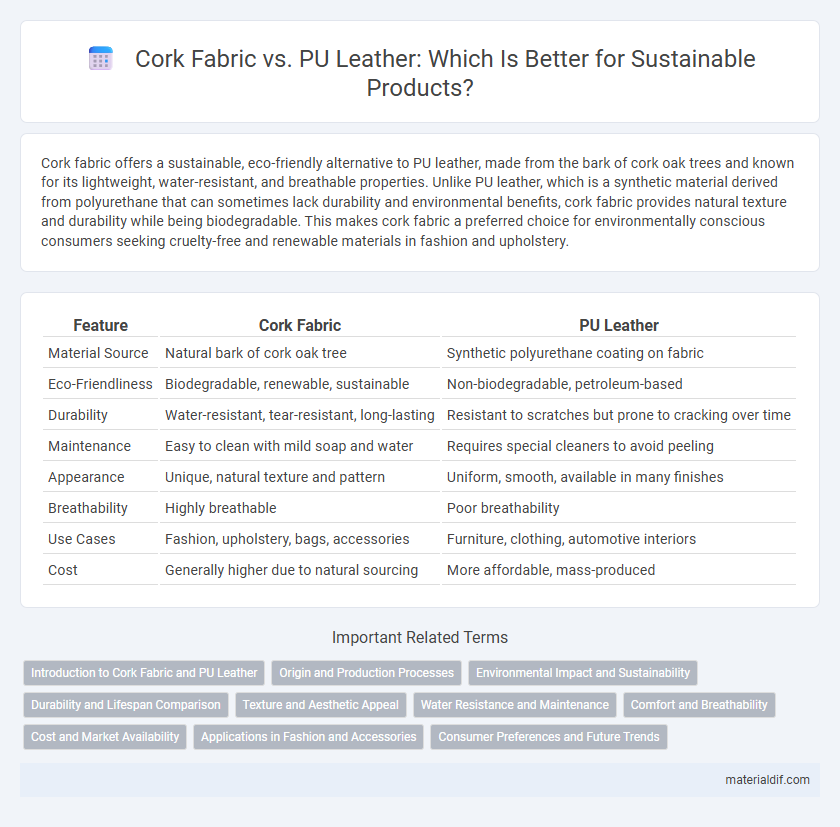Cork fabric offers a sustainable, eco-friendly alternative to PU leather, made from the bark of cork oak trees and known for its lightweight, water-resistant, and breathable properties. Unlike PU leather, which is a synthetic material derived from polyurethane that can sometimes lack durability and environmental benefits, cork fabric provides natural texture and durability while being biodegradable. This makes cork fabric a preferred choice for environmentally conscious consumers seeking cruelty-free and renewable materials in fashion and upholstery.
Table of Comparison
| Feature | Cork Fabric | PU Leather |
|---|---|---|
| Material Source | Natural bark of cork oak tree | Synthetic polyurethane coating on fabric |
| Eco-Friendliness | Biodegradable, renewable, sustainable | Non-biodegradable, petroleum-based |
| Durability | Water-resistant, tear-resistant, long-lasting | Resistant to scratches but prone to cracking over time |
| Maintenance | Easy to clean with mild soap and water | Requires special cleaners to avoid peeling |
| Appearance | Unique, natural texture and pattern | Uniform, smooth, available in many finishes |
| Breathability | Highly breathable | Poor breathability |
| Use Cases | Fashion, upholstery, bags, accessories | Furniture, clothing, automotive interiors |
| Cost | Generally higher due to natural sourcing | More affordable, mass-produced |
Introduction to Cork Fabric and PU Leather
Cork fabric, derived from the bark of cork oak trees, is a sustainable and eco-friendly material known for its durability, water resistance, and lightweight texture. PU leather, or polyurethane leather, is a synthetic leather alternative made by coating a fabric base with a layer of polyurethane, offering affordability, flexibility, and easy maintenance. Cork fabric stands out for its natural origin and breathability, while PU leather is favored for its versatility and smooth finish in various applications.
Origin and Production Processes
Cork fabric is derived from the bark of cork oak trees primarily found in the Mediterranean region, especially Portugal and Spain, where the bark is harvested sustainably without harming the tree. PU leather, or polyurethane leather, is a synthetic material made through a chemical process that coats a fabric base with a layer of polyurethane, typically produced in industrial settings worldwide. Cork fabric undergoes minimal processing, emphasizing natural preservation, while PU leather involves complex manufacturing steps to replicate the appearance and texture of genuine leather.
Environmental Impact and Sustainability
Cork fabric, harvested from the renewable bark of cork oak trees without harming them, offers a biodegradable and eco-friendly alternative to PU leather, which is derived from synthetic polymers and involves petroleum-based production processes. Cork's natural regeneration supports biodiversity and carbon sequestration, while PU leather contributes to microplastic pollution and has limited recyclability. Choosing cork fabric promotes sustainable materials with a lower carbon footprint and reduced environmental degradation compared to PU leather.
Durability and Lifespan Comparison
Cork fabric offers outstanding durability due to its natural resilience, water resistance, and resistance to wear, often lasting over a decade with proper care. PU leather, while visually similar to genuine leather, typically has a shorter lifespan of 2 to 5 years as it is prone to cracking and peeling with extended use. The sustainable, eco-friendly nature of cork fabric combined with its robustness makes it a superior choice for long-lasting, durable products.
Texture and Aesthetic Appeal
Cork fabric features a natural, slightly rough texture with visible grain patterns that create an organic and eco-friendly aesthetic, ideal for sustainable fashion and accessories. PU leather offers a smooth, uniform surface with a glossy or matte finish, mimicking genuine leather's luxurious look while allowing for diverse color options. The tactile experience of cork fabric tends to be more unique and breathable, contrasting with the sleek, polished feel of PU leather.
Water Resistance and Maintenance
Cork fabric is naturally water-resistant due to its waxy cellular structure, making it highly durable and easy to clean without the need for chemical treatments. PU leather requires a synthetic coating to repel water, which can wear off over time, reducing its water resistance and necessitating more frequent maintenance. Cork's eco-friendly properties and low upkeep make it a superior choice for water-resistant, long-lasting materials compared to PU leather.
Comfort and Breathability
Cork fabric offers superior breathability compared to PU leather, allowing air to circulate and reducing sweat buildup, which enhances overall comfort during extended use. Its natural cellular structure provides a soft, flexible texture that adapts well to body movements, unlike the synthetic surface of PU leather, which can trap heat and moisture. Cork's hypoallergenic and moisture-wicking properties make it an ideal material for users seeking breathable, comfortable alternatives to traditional PU leather.
Cost and Market Availability
Cork fabric generally costs more than PU leather due to its natural, sustainable harvesting process and limited production scale, making it a premium material in eco-friendly markets. PU leather enjoys widespread market availability and lower price points, driven by mass production and synthetic manufacturing methods. Retailers often stock PU leather products extensively, while cork fabric remains niche, primarily found in specialty and environmentally conscious brands.
Applications in Fashion and Accessories
Cork fabric offers a sustainable, lightweight alternative to PU leather, widely used in eco-friendly fashion accessories like bags, wallets, and shoes due to its natural water resistance and durability. PU leather remains popular for its affordability and versatility, allowing for a diverse range of textures and finishes in clothing and accessories. Designers choose cork fabric to appeal to environmentally conscious consumers, while PU leather suits mass-market products seeking cost-effective production.
Consumer Preferences and Future Trends
Cork fabric, derived from sustainable cork oak bark, appeals to eco-conscious consumers seeking natural, biodegradable alternatives to synthetic materials like PU leather. PU leather offers affordability, durability, and a wider range of textures, making it popular for budget-friendly fashion and upholstery markets. Future trends indicate growing demand for cork fabric in sustainable fashion and interior design due to increasing awareness of environmental impact and regulatory support for renewable materials.
Cork Fabric vs PU Leather Infographic

 materialdif.com
materialdif.com